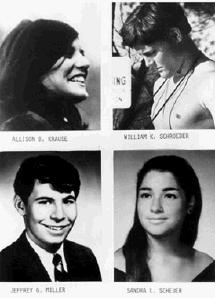 Kent State student John Filo's Pulitzer Prize-winning photo of Mary Ann Vecchio discovering the slain Jeffrey Miller.
Kent State student John Filo's Pulitzer Prize-winning photo of Mary Ann Vecchio discovering the slain Jeffrey Miller.
Originally posted here on May 4, 2008. (I read it on the air yesterday on our radio show, Occupy the Microphone.)
43 years ago on April 30, 1970, Richard Nixon announced that military operations would be expanding into the neutral, peaceful country of Cambodia, which had the bad fortune to share a border with Vietnam. Viet Cong insurgents were said to be hiding in the mountains of Cambodia. (In fact, the USA had already been conducting a secret bombing campaign, unbeknownst to the general public, engineered by Nixon and his butchers, named Alexander Haig and Henry Kissinger.) These illegal, immoral, reprehensible acts were the acts of criminally insane men, who had just realized they were losing their filthy, insane, extremely expensive war.
The result of this announcement was demonstrations on many American college campuses over the next few days. Nixon had promised to end the war, and proved to be a liar. The anger of the youth who would fight this war was palpable. At Kent State University in Ohio, demonstrators burned down an ROTC building. It was never known if this was deliberate or just an act of vandalism that got out of hand. Ostensibly due to this event, Governor James Rhodes declared Martial Law on the campus of Kent State University and sent the National Guard onto the campus. He also held a press conference in which he made famous inflammatory statements: "They're worse than the brownshirts and the communist element and also the night-riders and the vigilantes," Rhodes said. "They're the worst type of people that we harbor in America. I think that we're up against the strongest, well-trained, militant, revolutionary group that has ever assembled in America."
On May 4th, a demonstration was scheduled for noon. There were about 2000 people gathered for the demonstration, and about 1000 troops on campus. For unknown reasons, the Guard decided to break up the demonstration, and ordered the crowd to disperse. They were met with rocks and flying debris. The Guard responded with tear gas, and it was on.
I have read multiple versions of what happened next. Several facts dominate these versions: the kids were returning the tear gas cannisters (which do POP loudly like guns when they go off) and the Guard seemed very confused and didn't know what to do. At one point, none seemed sure of which direction to advance, but advance they did. At 12:22 PM, after guardsmen had advanced to the top of the hill near Taylor Hall and the parking lot, they turned and fired. They commenced firing for 13 seconds and fired 67 M-1 semiautomatic bullets. They wounded nine students, and murdered four in cold blood. Only two of these four students, Allison Krause and Jeffrey Miller, were actually demonstrating against the war. The remaining two, Sandra Scheuer and William Knox Schroeder, were merely changing classes.
 No one knows who gave the order to fire, if anyone did.
No one knows who gave the order to fire, if anyone did.
The kids in the National Guard were the same ages as the kids on the campus. These kids were all facing the same reality--the males of both groups were trying to avoid going to war. One group could afford college and the other could not, but could somehow get into the Guard. There is no question there was significant class hostility directed at the college kids by the Guard; the males in the Guard were closer to actual combat in Vietnam, although William Schroeder attended Kent on a ROTC scholarship and may well have intended to become an Officer himself.
From this incident, we learned that even the pampered children of the middle class were expendable. We learned that totalitarianism can erupt quickly and suddenly, particularly in small, contained areas where there exists considerable class hostility, panic, and loaded weapons. We learned that the Governor of Ohio was a fascist and a murderer, as was the President and his henchmen, all of whom nodded approvingly at the murders at Kent.
The lines were drawn very clearly, especially for me. I woke that morning in Ohio, to see that my state was all over the national news, all over the newspapers. We had various Moments of Silence for the next week. Everyone seemed to know someone involved. My grandmother cried and explained to me that these students were exercising their civil rights, and had been shot for it. "You have to remember this," she told me.
In the subsequent lawsuits, the families received an average of approximately $63,000 per student.
~*~
Ohio - Crosby, Stills, Nash and Young
Saturday, May 4, 2013
Kent State Remembered
Posted by
Daisy Deadhead
at
7:47 PM
![]()
Labels: Allison Krause, Cambodia, CSN, Dead Air Church, history, James Rhodes, Jeffrey Miller, Kent State, law enforcement, Neil Young, Nixon, Ohio, protests, Sandra Scheuer, US military, Vietnam, William Schroeder


